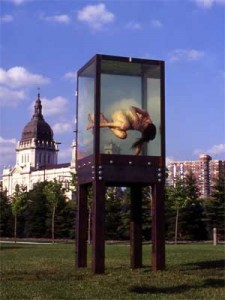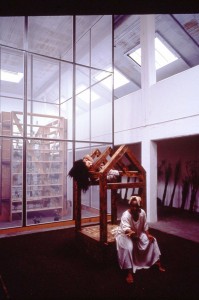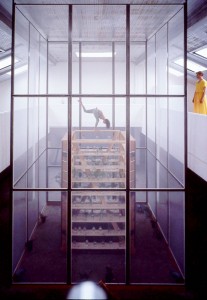Capp Street Project Artist in Residence: Reiko Goto & Joanna Haigood

May14 – June 26, 1993
Cho-Mu is an installation / performance work by choreographer Joanna Haigood and visual artist Reiko Goto performed by ZACCHO Dance Theater. Cho-Mu, which translates loosely from Japanese as “butterfly dreams”, uses movement and naturally occurring elements such as common urban butterflies and their host plants to suggest a metaphorical relationship between human growth and spiritual evolution. With an original score by Chicago composer Lauren Weinger, the work highlights the butterfly’s metamorphosis as a transformation common in our everyday environment yet hidden amidst the distractions and fast pace of 20th Century urban living. Reiko Goto is a San Francisco based artist who has created installation throughout Bay Area that take their inspiration from the observation of and interaction with animal life. Joanna Haigood is a dancer and choreographer who co-founded ZACCHO Dance Theater, a company that challenges formal notions of theater and creates an awareness of environment, nature, and situations that are evocative of human experience. ZACCHO dancers include Paul Benney, Joanna Haigood, Jo Kreiter, Sheula Lopez, Andy Meier, Jose Navarrete, Carmen Rodenstraten, and Shakiri.
Cho-Mu was commissioned by the Capp Street Project, San Francisco; Walker Art Center, Minneapolis; Dancing in the Street, New York; and Jacob’s Pillow , Massachusetts. Special funding for this project has been provided by the Rockefeller Foundation, the Lila Wallace-Reader’s Digest Fund, the Harkness Foundations for Dance, Arts Midwest/Dance on Tour, the Flintridge Foundation, the LEF Foundation, and the National Endowment for the Arts.

Program
- 1000 Different Bodies (house) / Shkiri
- The Egg (water tank) / Sheila Lopez
- Balance and the Caterpillar (shelves) / Jo Kreiter
- Meditation (stone circle) / Jose Navarette
- Leaving the Chrysalis (shadow box) / Paul Benney
- Return / The company
California Dreaming Against a Manhattan Backdrop
By Anna Kisselgoff
The New York Times; THE LIVING ARTS, Tuesday, August 3, 1993
Summer comes and along with it a host of dance companies whose members feel compelled to perform out of doors. What a surprise then to see something as imaginative as the Zaccho Dance Theater from San Francisco persuasively turning an overgrown garden on Roosevelt island, in New York City, into a beguiling fairytale setting on Friday night.

“Cho-Mu,” choreographed by Joanna Haigood, the company’s director, in collaboration with the visual artist, is very California in its message: Love the earth and revere the connection between all things, from butterflies to mankind.
Happily, the tale is couched in a style that has the refinement and indirectness of Japanese Haiku. Each of the six sections came across as a poetic image that drew upon archetypal resonance. The vivid movement was integrated with Ms. Goto’s ingenious and simple sculptures and installations. These ranged from a vertical water tank to a square of shelves for a soloist balancing at the top.
Dancing in the Streets, which presented “Cho-Mu,” translated the title from the Japanese as “Butterfly Dreams,” Ms. Haigood was the Wanderer, a dreamer who was a followed by the audience from site to site on a spiritual journey. Andy Meier, as the Tall Man, marched around on stilts under his Persian attire, appearing at crucial moments like a heavily messenger to release some butterflies from a box strapped to his chest.
At the very end, it was Ms. Haigood who released the last of the butterflies and watched them fly out against the ready-made backdrop of the trees and the 59 th Street Bridge.
A strong text, composed by Ms. Haigood and Shakiri, the dancer who recited it, introduced the theme of reincarnation and transformation. Shakiri embodied the life force (“I was born again in one thousand different bodies…I had been strong and frail…I am energy flowing from one life to another.”)
Leaving the outline of miniature house before which Shakiri had performed her priestly dance, Ms. Haigood led the audience across abandoned vegetable and flower plots to the water tank. Sheila Lopez, tumbling and weightless, her long hair floating upward, made this section, “The Egg,” as pure as it was surreal.

From water to plant life, Ms. Haigood came upon Jo Kreiter, a wonder of equilibrium who stood on one foot of did the split atop the bookshelf structure. Jars containing plants were ranged in rows on each shelf. Lauren Weinger’s sophisticated electronic score was thematically apt to each section. Joese Navarette twirled a pole and spun in place during a ritual dance inside a circle of stones.
Paul Benny was seen inside a shadow box, his nudity projected in silhouette. He grew more agitated and finally jumped through the translucent paper into the arms of Ms. Haigood standing below. It was a spectacular moment that left the audience gasping. “Leaving the Chrysalis” was the section’s understated title.
The fenale was daring. Each cast members stood atop a stepladder, gesturing. The butterflies, which had accompanied every evolutionary transformation, were all released. Well done.
